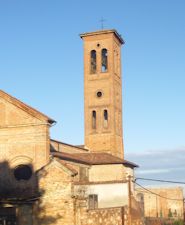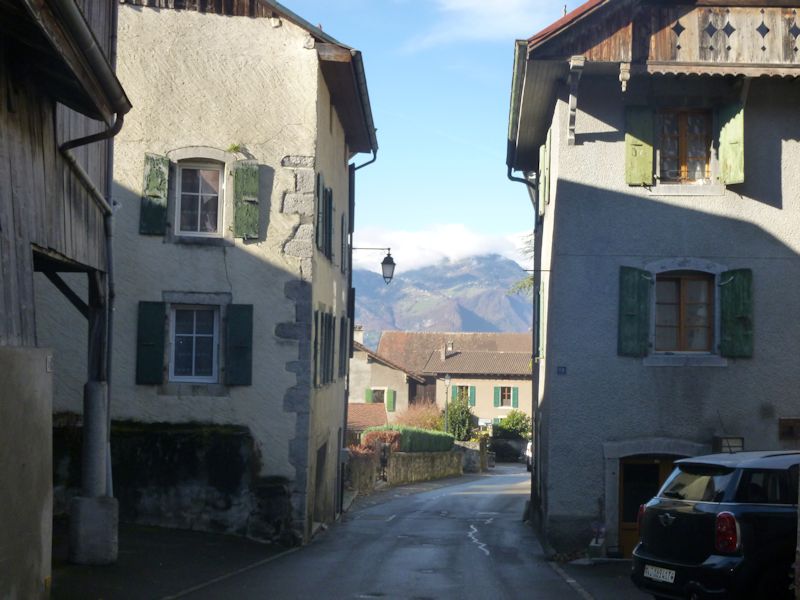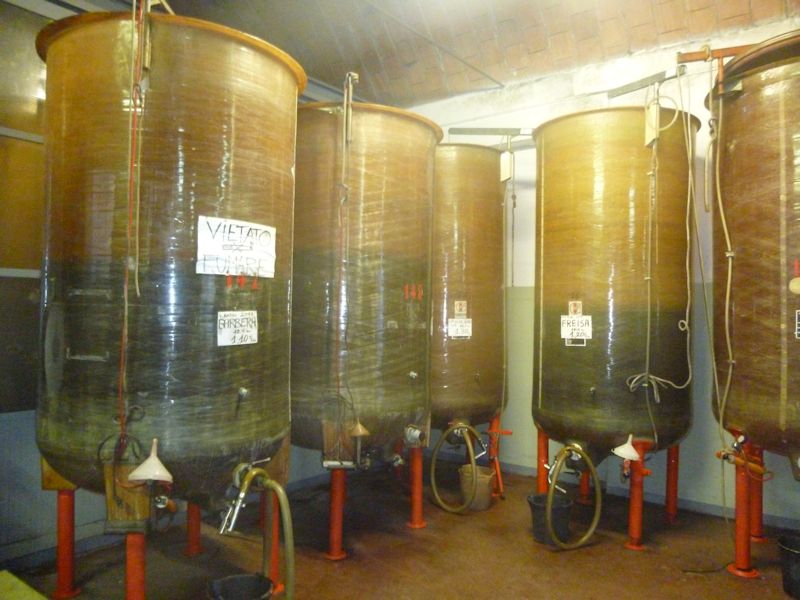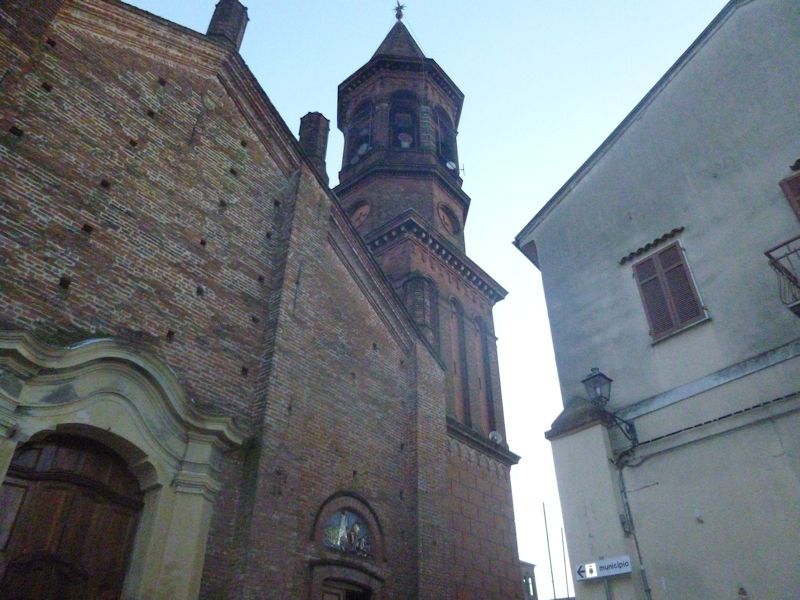|
 Dwight Peck's personal website Dwight Peck's personal website
Two weeks in Piemonte and Tuscany
in northwest Italy's worst weather in yonks
You may not find this terribly rewarding unless you're included here, so this is a good time for casual and random browsers to turn back before they get too caught up in the sweep and majesty of the proceedings and can't let go.
We wanted to visit Lucca and environs, but when we decided to break up the drive with a night spent halfway in each direction, one thing led to another.
So here we are in . . .
Lu, in the Piemonte region

We're leaving home in Ollon on a bright morning, 13 November 2014, bound over the Grand St Bernard, down the Aosta Valley and out onto the Po watershed in the Piemonte, or Piedmont, region . . .

. . . leaving the autostrada at Casale Monferrato in the ancient duchy of Monferrato, or Montferrat.

Thence by narrow country lanes past medieval hilltop villages, like this one, Lu.

We're booked at the very old Palazzo Paleologi in the heart of Lu, evidently first built by the then-Marquis of Monferrato of the Paleologus dynasty in the 14th century, and now largely restored, with rooms, apartments, and a restaurant called the Antico Monastero, upstairs on the left in this next photo.

The specialty seems to be hosting classy events, evidently, as the commune is sparsely populated and scarcely a tourist destination -- but they take pets in some rooms! and offer pension prices for room/dinners/breakfasts.

Parking is nearby just round the back. The Paleologus dynasty of the Eastern Roman Empire issued from a family of successful 11th-century generals who married into the Comnenid imperial family. Hiding out in Asia Minor after the Famously Weird Knights of the Fourth Crusade captured Byzantium instead of Jerusalem in 1204, the Paleologoi under Michael VIII Palaiologos recaptured Byzantium in 1261, and the family ruled the Eastern Empire until its fall to the Ottomans in 1453.

That's our flat on the left. From the Emperor Andronikos II's marriage to Irene of Montferrat, a cadet branch of the Paleologoi ruled the marquisate of Monferrato from the early 14th century until in 1536 it passed by marriage to the Gonzaga family of Mantova, where it remained until the early 18th century.

That's our pet-friendly flat there (sort of exiled from the main building).

A very suitable bedroom in the flat . . .

. . . and functional kitchen, etc. We're setting out for a lookaround in the village now.

That's the church of San Nazario next door (first documented from 1298), now used only for special events and not otherwise open to view.

That's the main block of the Palazzo Paleologi

The external street door of the Antico Monastero restaurant

The church of the Trinity near our hotel, dating from 1512

The Via Colli street just under the summit of the central hilltop, with the church of Santa Maria Nuova and, just to the right of it, the municipal administration.

The view northward towards the Alps, and a succession of hilltop villages between here and there. That one is Conzano just across the way.

The Alps, Monte Rosa looming, and the Matterhorn (Cervina) to the left. The village in front of Monte Rosa is probably Roncaglia; we passed through most of them on the way in but didn't pause to absorb their distinct cultural identities if any.

North Lu

Conzano again

Lu's church of Santa Maria Nuova, from the 14th century, closed at the moment. There are ten churches in the little village, and this is one of the two most important of them.

The church of San Biagio, attested from 1491, now out of service, but . . .

. . . with a nice belltower, as long as it lasts.

The commune's main square, down the hill a ways -- in fairly unflattering light

The church of San Giacomo, documented from 1298, probably the village's main church, dominating the village square

There's a white façade, probably from the 18th century, and a museum of the religious artistry attached to it, inaugurated in 2008, both of them open on Saturday morning.

Luese night life, the Rock Café Mephisto, presently resting up

The Cantina Sociale, a wine cooperative founded in 1906, the first in the region of what became a popular movement

I happen to be fond of Barbera d'Asti, a low-priced wine from this Asti region that's widely available elsewhere; Kristin is fiercely devoted to Grignolino, a lower-medium-priced local red that is difficult to find elsewhere. Here we have huge vats of both of them all around us. Oh joy oh bliss.

They're priced here basically as a giveaway, even in plastic bags-in-a-box if you prefer, so we've brought the car around and stuffed the boot with both frizzante and non-frizzante Grignolino, costing less than even the modest Swiss customs fee back at the border. There's no need to pack up on Barbera d'Asti as well -- that's already a giveaway at our nearest Aldi store at home.
(In A Farewell to Arms, the soldiers in the trenches at the Isonzo front in World War I complain about the officers getting fancy wines with their dinners, whilst the grunts are given "Barbera from Asti".

We're back to Santa Maria Nuova, which is closed for renovation, but the local religious person hurried out to regale us with amusing and uplifting stories of the church and region ("no priests from this parish have ever defected from the Church"); but we still never got to look round the church.

The belltower of the Chiesa della S. S. Trinità, back near our hotel.

It's time for dinner

Dinner in the hotel's Antico Monastero restaurant -- it's the off season and the room was sparsely populated both nights. The dinner was okay, the homemade amaro (which, as it's unlicensed for sale, they can only give you for free) was spectacular, and the breakfast was a chocolate croissant and two pieces of white bread, which you could toast if you wanted to, and put Nutella on it. It's the off season.

The next day, we're fogged in, and there's some concern that the roads to Genoa have been cut off by flooding, but this is our day to visit Asti 45 minutes down the road.

But first, after breakfast, we'll have another look around Lu.

A beautiful room, and a chocolate croissant with our coffee (we passed on the two pieces of white bread, with Nutella).

The hall below the restaurant

The courtyard of the Palazzo Paleologi in the rain

The Trinity church again

The Trinity church as we hobble up the hill in the centre of town

A beautiful little park dominates the commune of Lu

With a clock tower on top of it

And vistas in all directions

The tower dates from around 1400, but was strengthened and the clock added in 1633.

Santa Maria Nuova again

Now we're off to spend the afternoon in Asti, not too far off to the west. That's here. And then we're back to Lu for another chocolate croissant the following morning.
       
     

 Feedback
and suggestions are welcome if positive, resented if negative, Feedback
and suggestions are welcome if positive, resented if negative,  .
All rights reserved, all wrongs avenged. Posted 4 December 2014. .
All rights reserved, all wrongs avenged. Posted 4 December 2014.
|
 Dwight Peck's personal website
Dwight Peck's personal website


























































